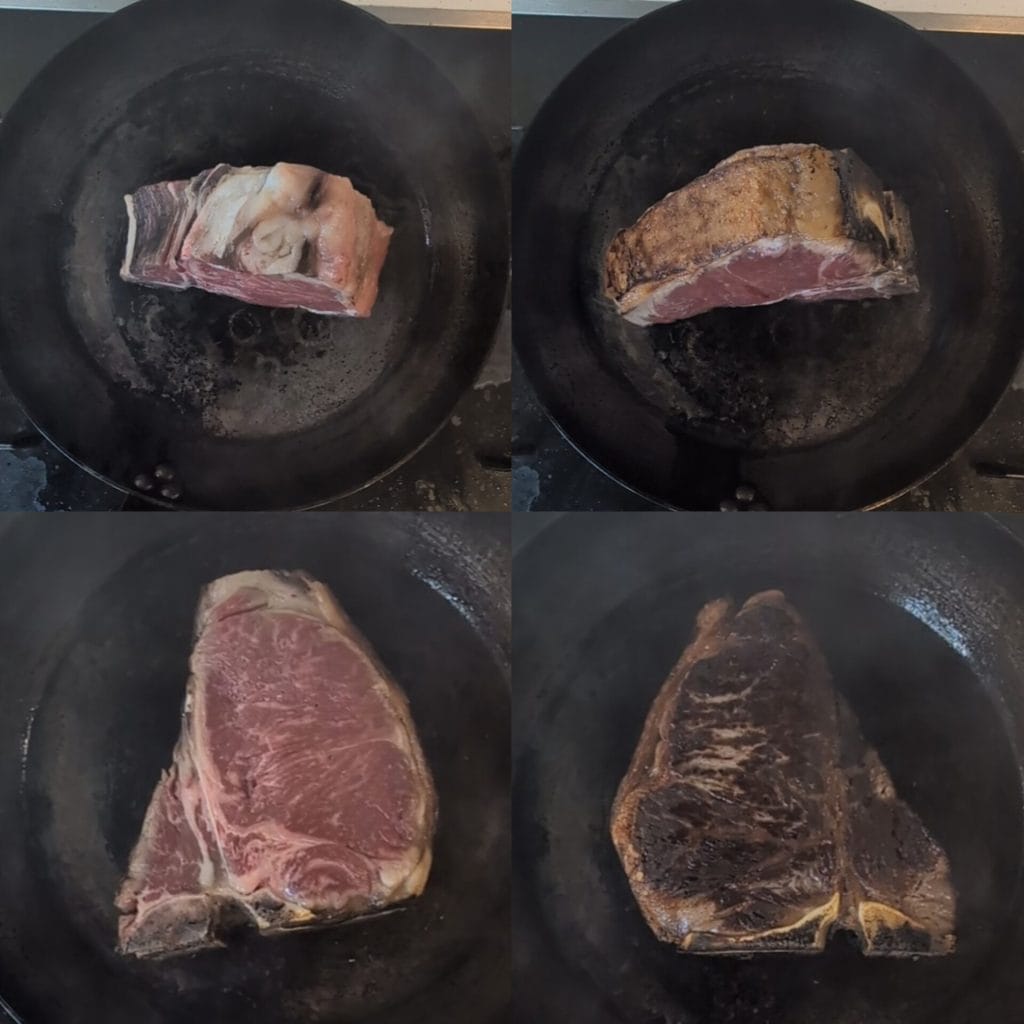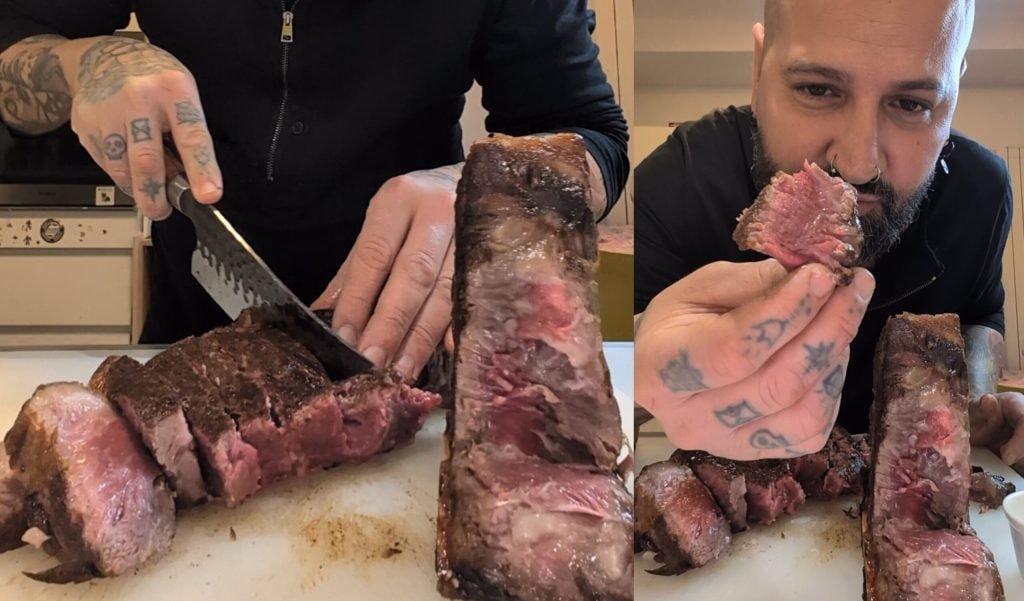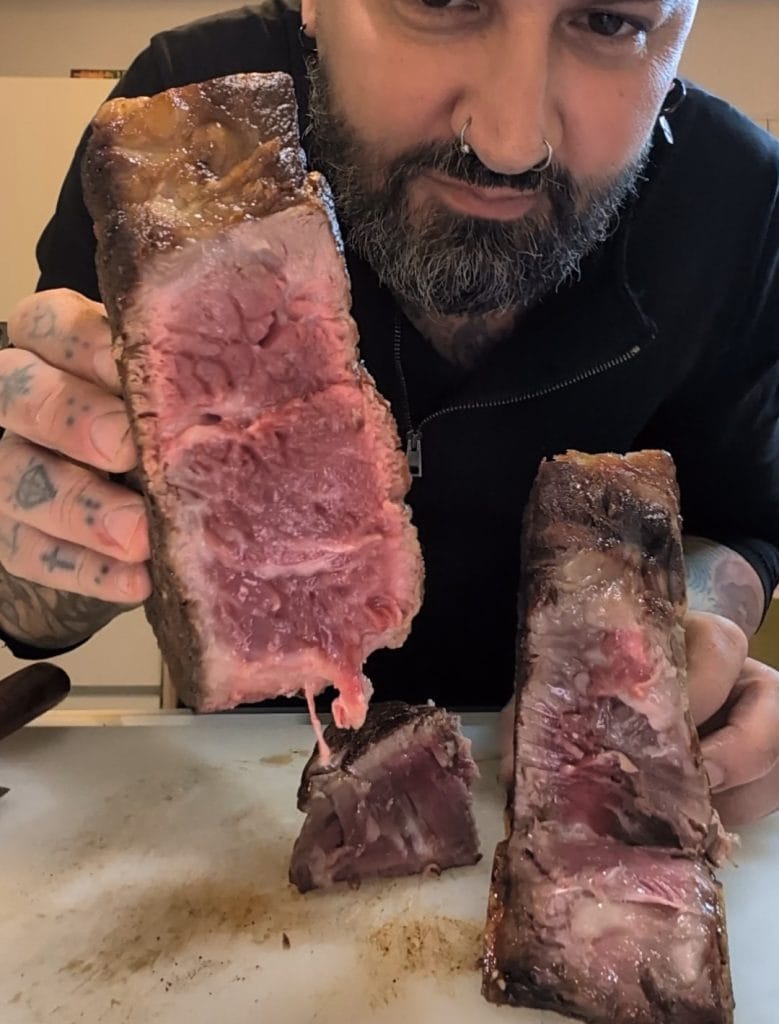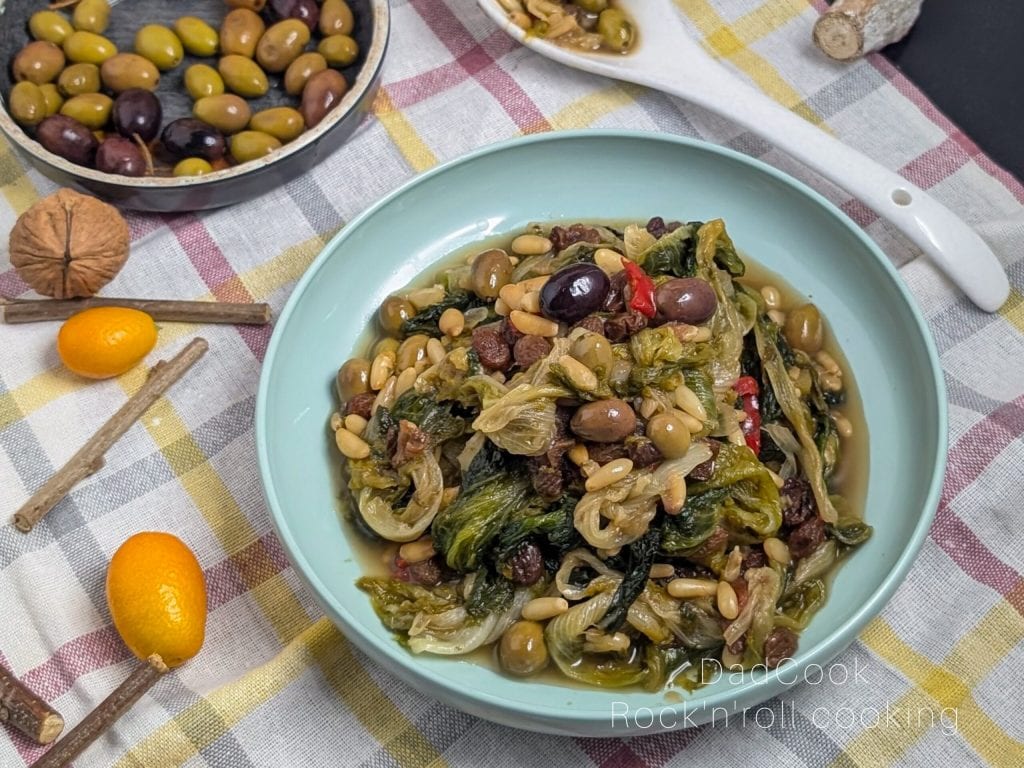Hello everyone! Today I will show you how to cook a Bavarian Simmental T-bone steak right on your home stove.
For those who don’t know, the T-bone is a premium cut of meat that includes the tenderloin and the strip steak, divided by the “T” shaped bone.
Bavarian Simmental is a cattle breed from Germany, known for its tender and flavorful meat.
Cooking such a thick steak on the stove might seem like a challenge, but I assure you it’s easier than you think. With the right technique, you will achieve perfect cooking, with a crispy crust on the outside and a tender, juicy center inside.
And I’ll tell you more: since I learned this method, my friends show up at my house unexpectedly, meat in hand, ready for a spontaneous “steak night”!
So, if you also want to impress your friends (and your taste buds!), read the recipe to the end, watch the video, and learn how to cook the Bavarian Simmental T-bone steak on your home stove!
- Tomahawk Steak: Discover the Secret for Perfect Cooking
- Spaghetti all'Assassina: How to Make Them Crunchy and Perfect
- Mushrooms and Potatoes in a Pan: Easy and Quick Recipe with Onion and Rosemary
- Recipe for 'Mpacchiuse Potatoes with Onion: Easy and Tasty
- The 10 Tastiest and Easiest Winter Recipes: First Courses, Second Courses, and Sides to Lick Your Lips!

- Difficulty: Very Easy
- Cost: Expensive
- Rest time: 10 Minutes
- Preparation time: 10 Minutes
- Portions: 2
- Cooking methods: Stove, Gas Grill
- Cuisine: International
- Seasonality: All Seasons, Spring, Summer, and Fall
- Energy 921.85 (Kcal)
- Carbohydrates 0.00 (g) of which sugars 0.00 (g)
- Proteins 99.94 (g)
- Fat 54.97 (g) of which saturated 0.00 (g)of which unsaturated 0.00 (g)
- Fibers 0.00 (g)
- Sodium 1,778.62 (mg)
Indicative values for a portion of 700 g processed in an automated way starting from the nutritional information available on the CREA* and FoodData Central** databases. It is not food and / or nutritional advice.
* CREATES Food and Nutrition Research Center: https://www.crea.gov.it/alimenti-e-nutrizione https://www.alimentinutrizione.it ** U.S. Department of Agriculture, Agricultural Research Service. FoodData Central, 2019. https://fdc.nal.usda.gov
Ingredients
- 2.87 lbs beef steak (Bavarian Simmental T-Bone)
- to taste Maldon salt
Tools
- 1 Iron Skillet Lionnese
Steps
Preparing the meat:
Remove the steak from the vacuum packaging, if present, and carefully pat it dry with paper towels.
This step is essential to dry the meat’s surface and promote the Maillard reaction during cooking, which will give your steak a crispy and flavorful crust.
Once patted dry, let it rest at room temperature for at least an hour before cooking.
This will allow the meat to reach an even temperature and cook more uniformly.

Pan cooking:
Heat a thick-bottomed iron or cast-iron skillet over high heat until it is very hot. The skillet material is crucial for successful cooking, as iron and cast iron distribute heat evenly and retain it for a long time.
Start cooking by placing the steak upright, with the bone touching the pan, for about 4 minutes. This helps warm the center of the meat.
After 4 minutes, lay the steak on one side and cook it for 2-3 minutes, then sear it for another 2-3 minutes on the fatty side and finally on the other two sides.
This step seals the meat and creates the Maillard reaction, that golden, flavorful crust we all love.
Now cook the steak for 4 minutes on one side, without moving it, and then for another 4 minutes on the other side. This timing is indicative of a “blue” cooking, which is before rare cooking.
This type of cooking is preferred by true carnivores who want to fully enjoy the flavors and juiciness of the meat. For perfect cooking, I recommend using a meat thermometer.
The target internal temperature for “blue” cooking should be around 118-122°F.
If you prefer a different doneness, adjust the timing according to your preferences.
Meat cooking time:
Blue 118°/122°
Rare 124°/126°
Medium 129°/131°
Medium Well 133°/138°
Well Done 140°/154°

Rest:
Once cooked, remove the steak from the skillet and let it rest covered with aluminum foil for at least the cooking time.
In this case, having cooked it for 4 minutes per side, let it rest for at least 8-10 minutes.
This step is crucial to allow the meat’s juices to redistribute evenly, ensuring a tender and juicy steak.

Cut and final cooking (if necessary):
After the resting time, cut the steak separating the T-bone from the tenderloin and strip steak.If you like “blue” cooking, you can enjoy it immediately with a pinch of Maldon salt flakes, which will enhance the meat’s flavor without overpowering it.
If you prefer rare or more cooked, you can return the meat to the skillet or oven for a few minutes, adjusting the doneness to your liking.Remember that it is essential to let the meat rest before cutting it because during cooking, muscle fibers contract and push the juices outward.
If we were to cut the meat immediately, these juices would escape, leaving the steak dry and tough. By waiting a few minutes, we allow the fibers to relax and the juices to redistribute, ensuring a tender and juicy steak.

Plating:
Serve your Bavarian Simmental T-bone steak on a serving plate, accompanied by the bone and a pinch of Maldon salt flakes.If desired, you can add a drizzle of raw extra virgin olive oil. Enjoy your meal!

Here are some storage tips and variations for your Bavarian Simmental T-bone steak recipe:
Storage:
Fresh Meat:
If you purchased fresh meat, it is best to cook it within 2-3 days. Store it in the refrigerator, wrapped in butcher paper or in an airtight container, at a temperature between 32°F and 39°F.
Frozen Meat:
If you purchased frozen meat, thaw it slowly in the refrigerator for 24 hours before cooking.
Once thawed, cook it within 24 hours.
Never refreeze meat after thawing.
Cooked Meat:
If you have leftover cooked steak, store it in the refrigerator in an airtight container and consume it within 2-3 days. You can reheat it in a skillet or oven at a low temperature.
Tips:
Meat Quality:
Make sure to purchase a high-quality Bavarian Simmental T-bone steak, preferably aged for at least 20 days.
This will ensure more tender and flavorful meat.
Steak Thickness:
The ideal thickness for a T-bone cooked in a skillet is at least 1.5-2 inches.
This will allow for even cooking, with a crispy crust on the outside and a tender center inside.
Skillet Temperature:
The skillet must be very hot before placing the steak in it.
This allows the meat to sear and creates the Maillard reaction.
Rest Time:
Do not underestimate the importance of resting the meat after cooking. This step is crucial for allowing the meat’s juices to redistribute evenly, ensuring a more tender and juicy steak.
Seasonings:
The Bavarian Simmental T-bone is a meat with a rich and intense flavor that does not require many seasonings. A pinch of Maldon salt flakes and a drizzle of raw extra virgin olive oil are enough to enhance its taste.
Variations:
Herbs:
You can add aromatic herbs to the skillet during cooking, such as rosemary, thyme, sage, or garlic.
Butter:
Towards the end of cooking, you can add a knob of butter to the skillet to flavor the meat and create a delicious sauce.
Wine:
You can deglaze the skillet with red or white wine to create a richer and more aromatic sauce.
Sides:
Accompany your T-bone with classic sides such as roasted potatoes, grilled vegetables, or salad.
Sauces:
If you want to add an extra touch, you can serve the steak with sauces on the side, such as Béarnaise sauce, green pepper sauce, or chimichurri sauce.
I hope these tips and variations are helpful!
Enjoy your meal! 😋
Enjoy your meal! 😋

Wine Pairings for Bavarian Simmental T-Bone Steak:
The Bavarian Simmental T-bone steak, with its flavorful and succulent meat, pairs well with red wines of good structure and complexity.
Here are 6 wines that will best enhance the taste of this steak:
Chianti Classico Riserva (Tuscany):
A great classic of Italian winemaking, with soft tannins, balanced acidity, and notes of red fruits, spices, and tobacco.
Brunello di Montalcino (Tuscany):
A powerful and elegant wine, with aromas of cherry, plum, leather, and licorice. Its robust tannins pair perfectly with the succulence of the meat.
Amarone della Valpolicella (Veneto):
A full-bodied and structured wine, with notes of ripe fruit, spices, and chocolate. Its alcoholic warmth and aromatic persistence balance the richness of the T-bone.
Barolo (Piedmont):
A majestic and complex wine, with aromas of rose, violet, truffle, and spices. Its noble tannins and vibrant acidity cleanse the palate from the meat’s succulence.
Cabernet Sauvignon (California):
An international wine of great structure and concentration, with notes of blackcurrant, cedar, and vanilla. Its aromatic power pairs well with the meat’s savoriness.
Sagrantino di Montefalco (Umbria):
A powerful and tannic wine, with aromas of blackberry, plum, cocoa, and tobacco. Its structure and aromatic persistence match well with the complexity of the T-bone.
Tips:
Serve the wine at a temperature of 64-68°F to best appreciate its aromas.
Choose the wine based on the meat’s doneness: for “blue” or rare doneness, opt for wines with softer tannins, while for more prolonged cooking, choose more structured wines.
Experiment and have fun finding the perfect pairing for your taste!
Cheers! 🍷
FAQ (Frequently Asked Questions)
Here are some frequently asked questions about the Florentine T-bone steak:
What is the difference between a Florentine and a T-bone?
The main difference lies in the breed of cattle. The “Florentine” par excellence comes from the Chianina breed, raised in Tuscany. The T-bone, however, can come from various cattle breeds, such as the Bavarian Simmental in this case. Both have the characteristic “T” shaped bone, with the tenderloin on one side and the strip steak on the other.

What is the ideal thickness for a Florentine steak?The ideal thickness is at least 1.5-2 inches, to allow for even cooking and to keep the meat juicy inside.

How do you cook a Florentine steak on the stove?
Heat an iron or cast-iron skillet well. Sear the meat on all sides, then cook it for 3-4 minutes per side for rare, increasing the time as desired for more doneness. It is important to let the meat rest after cooking.
What type of skillet is best to use?
An iron or cast-iron skillet, with a thick bottom, is ideal for cooking Florentine steak. These materials distribute heat evenly and retain it for a long time.

How do you know when the steak is cooked to the right doneness?
You can use a meat thermometer for greater accuracy. The target internal temperature for rare is about 131°F, for medium doneness is 140-149°F, and for well done is 158°F or higher.

What are the ideal seasonings for Florentine steak?
A pinch of Maldon salt flakes and a drizzle of raw extra virgin olive oil are enough to enhance the meat’s flavor.

What can you serve with Florentine steak?
Roasted potatoes, grilled vegetables, mixed salad, or sautéed spinach are excellent sides for Florentine steak.

Can Florentine steak be cooked in the oven?
Yes, it is possible to cook Florentine steak in the oven after searing it in a skillet. This method is ideal for longer cooking times.
How do you store Florentine steak?
If the meat is fresh, store it in the refrigerator for 2-3 days. If it is frozen, thaw it in the refrigerator for 24 hours before cooking. Cooked steak can be stored in the refrigerator for 2-3 days.
What wines pair with Florentine steak
?Red wines with good structure, such as Chianti Classico, Brunello di Montalcino, Amarone della Valpolicella, Barolo, or Cabernet Sauvignon.

